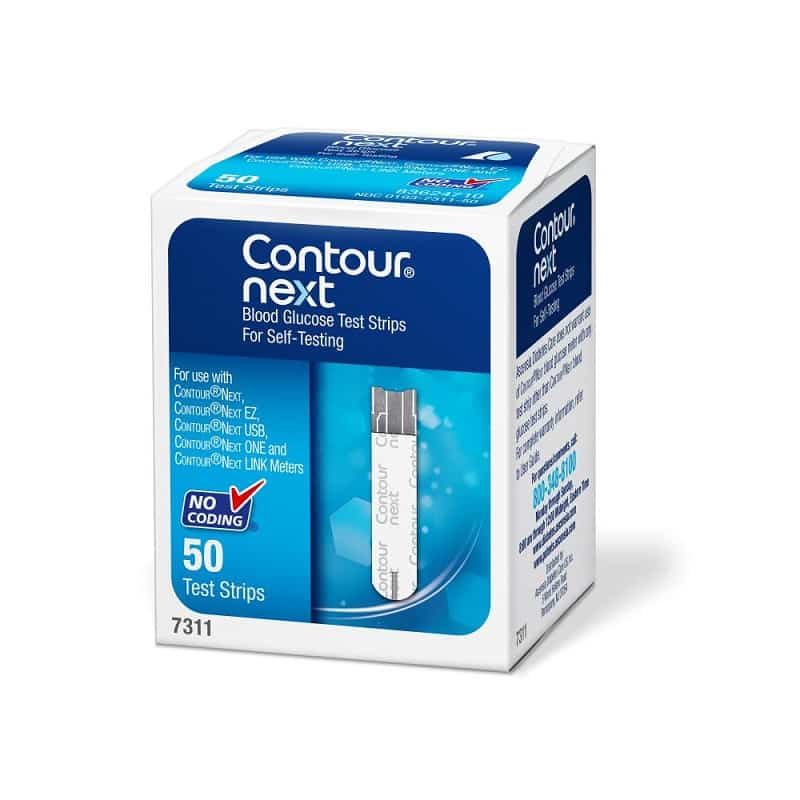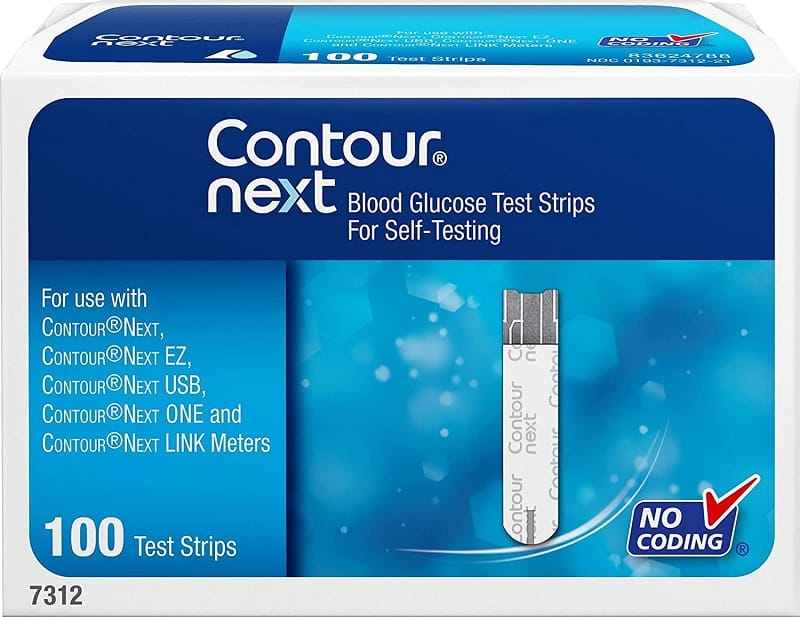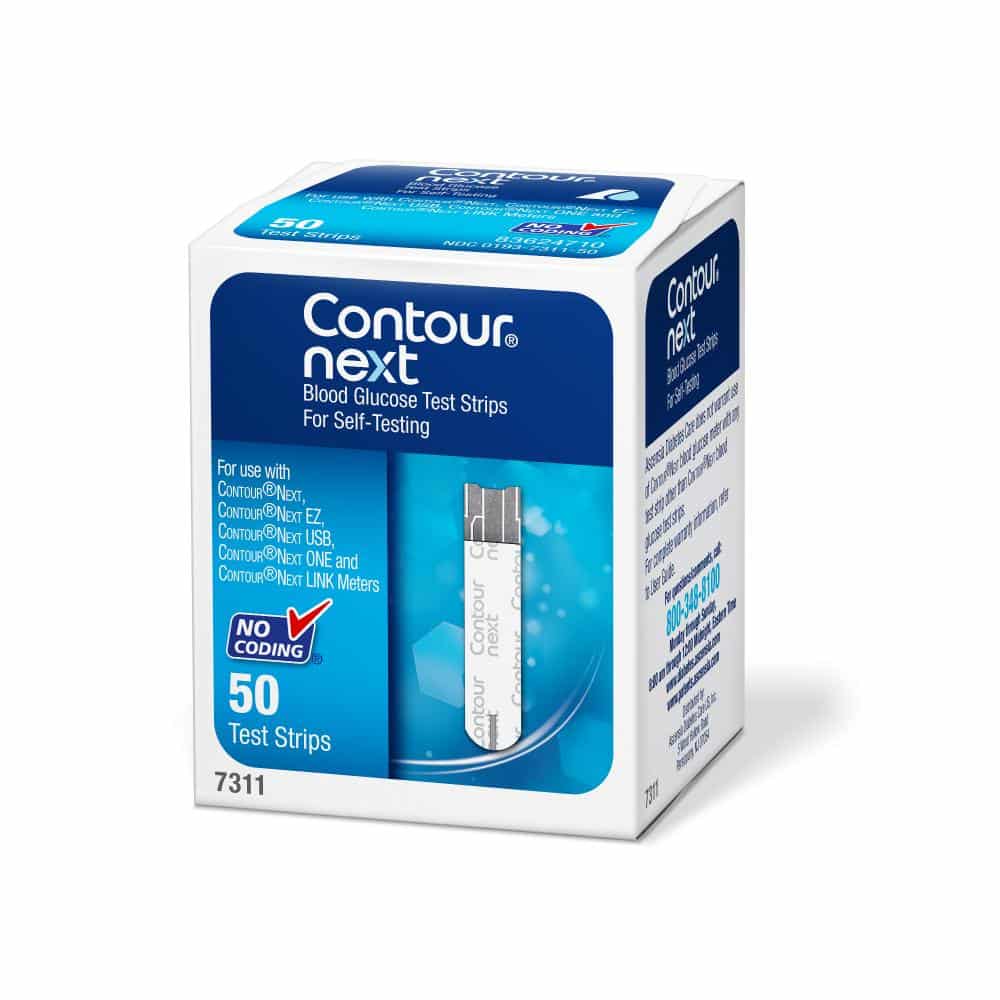Shipping with this method takes 3-5 days
Contour Next® Test Strips for Blood Glucose Monitoring
Sitewide Super Sale - Get 15% off when you buy 3 or more of the same product using the code LESS15 at checkout.
Applies to all products originating from Canada. Maximum quantity limited to a 90-day supply per order.
Price range: $48.74 through $81.15
You save


These test strips are designed for self-monitoring of blood glucose. They work with compatible meters to provide capillary blood readings from a fingertip sample. You can order with US shipping from Canada and consider cash-pay options without insurance.
What Contour Next Is and How It Works
Contour Next® test strips are single-use diagnostic strips used with compatible Contour Next meters to measure blood glucose. The enzyme chemistry in the strip reacts with a tiny drop of blood and the meter converts that signal into a reading. Results help guide day-to-day diabetes decisions as directed by your care team.
CanadianInsulin.com is a prescription referral platform. We verify prescriptions with your prescriber when required, and licensed Canadian pharmacies dispense your order.
These strips are code-free with supported meters, reducing user steps. Many meters in this family allow second-chance sampling, which may help reduce wasted strips if the first drop was insufficient.
If you need a compatible device, see the Contour Next EZ meter for an integrated experience.
For more on monitoring tools, you can review general guidance in our article on Glucose Monitors.
Who It’s For
These strips are intended for people managing diabetes who use Contour Next family meters. They are for self-testing of blood glucose using capillary whole blood.
They are not for diagnosing diabetes or for testing arterial, venous, or neonatal samples. If your meter is not listed as compatible, do not use contour glucose strips with it. For additional supplies, browse our Test Strips category.
Dosage and Usage
Follow your clinician’s plan for how often to check. Typical times include before meals, two hours after eating, at bedtime, or when symptoms of high or low blood sugar are present. Frequency varies by treatment and goals.
General steps:
- Prepare meter and strip: insert a new strip into the meter.
- Wash and dry hands: warm water helps blood flow.
- Lance fingertip: use a fresh lancet and adjust depth.
- Apply blood to the strip tip: let capillary action draw the drop in.
- Wait for the reading: follow meter prompts for a result.
Some meters allow a second fill if the first drop is too small. Refer to your meter manual for supported features. If you use a lancing device, compatible options include Microlet Lancets. If your routine involves the EZ model, these are the standard strips for contour next ez meters.
Use one strip per test. Do not reuse or add extra blood after the meter has begun analyzing unless the meter specifically prompts for a second fill.
Strengths and Forms
Packaging commonly includes vials of 50 or 100 strips. Availability can vary by batch, manufacturer packaging, and region. Many users prefer 100-count options for fewer refills, while others choose smaller vials for portability or lower up-front cost.
When assessing quantities, you may see references to formats like contour strips 50 or 100-count cartons. Select a size that aligns with your expected monthly testing frequency and your clinician’s plan.
Missed Dose and Timing
If you miss a planned check, test when you remember and resume your normal schedule. For illness, medication changes, or unusual readings, follow your clinician’s testing recommendations.
Do not stack repeated tests unnecessarily. If the result appears inconsistent with how you feel, wash hands, use a new strip, and repeat. Consider a control solution check if your meter and strips support it.
Storage and Travel Basics
Keep strips in the original vial with the cap closed. Store at room temperature as directed on the label, away from heat, humidity, and direct sunlight. Do not transfer strips to another container. Do not refrigerate or freeze unless the official label instructs otherwise.
Open only one vial at a time and use strips before the expiration date. Discard strips that are expired, damp, damaged, or exposed to contaminants. If a vial was left open, readings may be unreliable.
When traveling, keep supplies in carry-on luggage in a protective case. Bring extra strips, meter batteries, and a backup meter if possible. Pack your prescription or a physician letter if you use insulin or injectable therapies. For general diabetes supplies, you can also explore Diabetes Supplies on our site. For best results with contour blood sugar test strips, avoid extreme temperatures and follow the meter manual.
Benefits
This testing system can offer straightforward setup with supported meters and no manual coding. A small blood sample may be sufficient, and some devices allow a second-chance fill to help reduce waste.
Clear numerical readings, optional markers, and data transfer features on certain meters can help you and your care team review patterns. Convenience may improve adherence to your checking plan.
Side Effects and Safety
- Finger discomfort: brief pain or tenderness from lancing.
- Skin irritation: rare redness at the puncture site.
- Bruising: occasionally at frequent testing sites.
- User error: insufficient sample leading to inaccurate results.
Serious events are uncommon from strip use alone. Inaccurate readings can occur with improper storage, contaminated hands, extreme temperatures, or using incompatible meters. If a reading does not match symptoms, wash hands and retest with a new strip. Seek medical advice for symptoms of severe hypoglycemia or hyperglycemia.
Drug Interactions and Cautions
These strips do not interact with medicines in the usual sense. However, certain physiological conditions and substances can affect glucose readings. High or low hematocrit, severe dehydration, shock, or high altitude can influence results. Always consult the meter and strip inserts for any listed interfering substances and operating ranges.
Use only with compatible meters. Do not use if the vial or desiccant is missing or damaged. Do not share lancing devices. Follow local rules for sharps disposal.
What to Expect Over Time
With proper technique, you can expect consistent meter readings that reflect your capillary blood glucose. You may refine your testing times based on your care plan and pattern review. Many users establish a routine around meals and activity.
Clean hands, fresh lancets, and well-stored strips help maintain accuracy. If your clinician adjusts your monitoring goals, your daily testing frequency may change. To learn more about device choices and features, see our overview of Glucose Monitors.
Compare With Alternatives
Other leading test strips include FreeStyle Lite Strips, which pair with FreeStyle meters known for small sample size and portable designs. Another option is OneTouch Verio Strips, designed for the Verio meter family and broad retail availability.
Talk with your clinician about meter compatibility, visibility features, and data-sharing needs when comparing systems. If you need contour next test strips for sale, verify your meter model before ordering.
Pricing and Access
We provide transparent pricing and options that may reflect Canadian market rates with US fulfillment. This helps many customers compare out-of-pocket costs. You can check current stock and place an order that Ships from Canada to US with direct-to-home service.
If you are looking for a contour test strips coupon, see our Current Promotions for any active offers. We support encrypted checkout to protect your information.
Availability and Substitutions
Supply can vary by lot and packaging size. If unavailable, your prescriber or diabetes educator may suggest a compatible alternative and meter pairing. Do not substitute strips across meter brands without professional guidance.
Patient Suitability and Cost-Saving Tips
These strips may suit adults and adolescents who need capillary blood glucose monitoring with supported meters. People with severe anemia or polycythemia should consult product inserts for hematocrit limits. For young children, caregivers should supervise testing.
Cost-sensitive users can consider multi-month quantities to reduce per-shipment fees. Set refill reminders based on your average daily tests, and keep a small reserve for travel or sick days. If you also need a compatible meter, consider the Contour Next EZ starter option alongside strips.
Questions to Ask Your Clinician
- Testing frequency: when should I check each day?
- Target ranges: what pre- and post-meal goals fit my plan?
- Meter compatibility: does my model support second-chance sampling?
- Control solution: how often should I run a quality check?
- Alternate sites: am I a candidate for forearm testing?
- Data review: how should I share readings for care adjustments?
Authoritative Sources
For official product specifications and safety information, review these sources:
- Ascensia Diabetes Care manufacturer information for general product support and device family details.
- FDA 510(k) database for cleared glucose testing systems and related submissions.
- Health Canada medical devices listings for licensing status and device records.
Order from CanadianInsulin for prompt, express shipping with temperature-controlled handling when required.
Medical disclaimer: This content is for informational purposes only and is not a substitute for professional medical advice.
Express Shipping - from $25.00
Prices:
- Dry-Packed Products $25.00
- Cold-Packed Products $35.00
Standard Shipping - $15.00
Shipping with this method takes 5-10 days
Prices:
- Dry-Packed Products $15.00
- Not available for Cold-Packed products
Are Contour Next Test Strips compatible with my meter?
They work only with Contour Next family meters, such as Contour Next One and Contour Next EZ. Check your meter model and the strip insert before use.
Do I need a prescription to buy these strips?
In many regions, glucose test strips are sold over the counter. We verify prescriptions when required by law or by the dispensing pharmacy.
How long do strips last after opening the vial?
Use strips before the printed expiration date and follow the insert for any open-vial usage guidance. Discard strips that are damaged or exposed to moisture.
Can I reuse a strip or add more blood?
No. Strips are single-use. Apply a sufficient drop the first time. Only add more blood if your meter specifically prompts for a second-chance fill.
What if the reading does not match how I feel?
Wash hands, repeat with a new strip, and run a control solution check if available. Seek medical advice for symptoms of severe highs or lows.
Are alternate sites like the forearm acceptable?
Some meters support alternate site testing in specific situations. Confirm in your meter manual and ask your clinician if it is appropriate for you.
How should I dispose of lancets and used strips?
Place used lancets in an approved sharps container and follow local rules. Used strips can go in household trash unless local regulations state otherwise.
Rewards Program
Earn points on birthdays, product orders, reviews, friend referrals, and more! Enjoy your medication at unparalleled discounts while reaping rewards for every step you take with us.
You can read more about rewards here.
POINT VALUE
How to earn points
- 1Create an account and start earning.
- 2Earn points every time you shop or perform certain actions.
- 3Redeem points for exclusive discounts.
You Might Also Like
Related Articles
Zepbound storage: Keep It Safe With Clear Temperature Rules
This guide explains Zepbound storage so your medication stays effective. You will learn temperature limits, how long doses can stay unrefrigerated, travel practices, and what to do if a pen…
Zepbound and Fatigue: Practical Tips to Ease Tiredness Safely
Feeling drained after starting tirzepatide can be unsettling. Many users describe a mix of low energy, mild aches, and disrupted sleep early on. If you are navigating Zepbound and fatigue,…
Mounjaro Heart Benefits Beyond Weight Loss: Evidence-Based Guide
Interest has grown around Mounjaro heart benefits as clinicians evaluate tirzepatide’s broader impact beyond glucose control and weight. Patients want clear, cautious guidance. This overview explains what current data suggests,…
Ozempic Rebound: A Practical Guide to Prevent Weight Regain
Many people stop GLP-1 therapy and wonder what comes next. Appetite changes, routine shifts, and metabolism can collide. A clear plan helps you keep progress steady and predictable, not reactive.…



